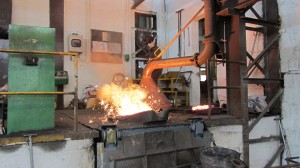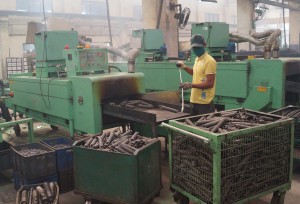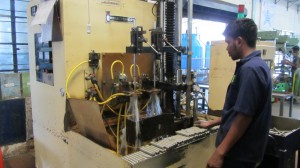T Murrali
With the expectations of vehicle end-users ever increasing, OEMs are under constant
pressure to retain market share, let alone increase it. They eventually exert pressure
on the component manufacturers whose challenges are snowballing in terms of cost,
quality and delivery. While these expectations are managed by large companies, they
may appear humongous for SMEs.
 In the last couple of decades, the auto component manufacturing industry in India has evolved significantly in terms of quality, cost and delivery. Alongside, the expectations are increasing and, therefore, the goal post is drifting. Today, suppliers work comfortably with OEMs from across the globe, understanding different work cultures. It has percolated down to the Tier 2 and, to some extent, Tier 3 players due to the increasing influence and presence of global automotive companies in India. This has indeed added to the quality of products manufactured in India. Evidence of this is that India exported $ 9.7 billion worth of auto components largely to Tier-1s and OEMs, which would not have been possible had the products not met stringent global quality benchmarks. The Indian auto component industry today boasts of the largest number of Deming Award winners outside of Japan. While this is true largely for the Tier-1s, the smaller companies need to significantly invest in both quality and productivity for sustainable competitiveness.
In the last couple of decades, the auto component manufacturing industry in India has evolved significantly in terms of quality, cost and delivery. Alongside, the expectations are increasing and, therefore, the goal post is drifting. Today, suppliers work comfortably with OEMs from across the globe, understanding different work cultures. It has percolated down to the Tier 2 and, to some extent, Tier 3 players due to the increasing influence and presence of global automotive companies in India. This has indeed added to the quality of products manufactured in India. Evidence of this is that India exported $ 9.7 billion worth of auto components largely to Tier-1s and OEMs, which would not have been possible had the products not met stringent global quality benchmarks. The Indian auto component industry today boasts of the largest number of Deming Award winners outside of Japan. While this is true largely for the Tier-1s, the smaller companies need to significantly invest in both quality and productivity for sustainable competitiveness.
 It is said that slowdown is the best time to look back on what each company has done thus far, and improve upon it. Also, this is the time best suited to innovate, not only products but also new methodologies in manufacturing that can be cost effective, eventually improving the bottom line. Quite a few large companies invest during the slowdown as they benefit on a few counts including availability of time, materials at competitive cost and also cheap labour. However, the Small and Medium Enterprises (SMEs) do not have these luxuries though the challenge continues to be on enhancing quality, reducing cost and improving on-time delivery. In this scenario, can SMEs think of automation? Is this the way out for them to improve quality and delivery where cost is largely determined by their customers?
It is said that slowdown is the best time to look back on what each company has done thus far, and improve upon it. Also, this is the time best suited to innovate, not only products but also new methodologies in manufacturing that can be cost effective, eventually improving the bottom line. Quite a few large companies invest during the slowdown as they benefit on a few counts including availability of time, materials at competitive cost and also cheap labour. However, the Small and Medium Enterprises (SMEs) do not have these luxuries though the challenge continues to be on enhancing quality, reducing cost and improving on-time delivery. In this scenario, can SMEs think of automation? Is this the way out for them to improve quality and delivery where cost is largely determined by their customers?
Classification
According to the MSME Development Act 2006, enterprises in India are classified based on the investments in plant and machinery. Firms having investments below Rs 25 lakh are considered micro-enterprises, while those above Rs 25 lakh and up to Rs 5 crore are considered as small enterprises, and the ones with investment between Rs 5 crore and Rs 10 crore are considered medium enterprises. In India MSMEs employ around 60 million people and are considered to be the second largest providers of employment, the first being agriculture.
The auto component industry in India is largely dominated by the SMEs. In fact 70% of the 700 plus membership of Automotive Components Manufacturers’ Association of India (ACMA) are SMEs. The auto component industry in India recorded a turnover of $39.7 billion in 2012-13 with a contribution of 2.2% to the total GDP of India According to the Chairman of SME Committee of the Automotive Components Manufacturers’ Association of India (ACMA) and MD, New Swan Group, Upkar Singh Ahuja, SMEs face a number of problems such as absence of adequate and timely banking finance, delay in payments from buyers, limited capital and knowledge, non-availability of suitable technology, low production capacity, ineffective marketing strategy, limited access to newer markets, constraints on modernisation and expansion, non-availability of high skilled labour at affordable cost and delays in government clearances.

C Siva Kumar, CEO
– Prabha Engineers
& Management Committee Member and Founding Chairman of Hosur Chapter – Madras Management Association
Financing this is the single biggest challenge faced by SMEs today despite showing tremendous growth and doing better than some large corporations in terms of employment generation and Gross Value Addition (GVA) growth. SMEs have to pay a very high cost of capital for the funds they get from the market, which leads to a high degree of risk. This further increases the cost of capital for them, making it a vicious circle. While it is easy for large and established players in the industry to raise funds, it is not the same case with SMEs. In a country like India, there are very few angel investors willing to invest in such companies. Another major problem faced by SMEs is limited access to financial resources which impact their credit ratings; with the result that investors are unaware of the risks involved in investing in such a business.
Taking a leaf out of a survey he said that more than 56% of SMEs depend on self – financing for their innovation activities, and almost 67% do not get finance from traditional channels. Most of them have to operate for almost 10 years in a financial crisis, and have to depend on self-financing or non-traditional financing methods for survival. Innovation based SME’s depend on University funds to finance their R&D.
Listing out the challenges K P Gopal, Convenor of the MSME Panel, CII-Chennai zone and Director, Stuser Tools, says the biggest challenge for the SMEs in the current scenario is to achieve sustained growth in a dynamic market situation. The hurdles for such growth can be the ability to identify and acquire the right technology, the cost and timely availability of finance and overcoming the ‘small’ mindset that many of them are comfortable with.
According to Raj Singh Rathee, Managing Director, Kuka Robotics (India) Private Limited, the biggest challenge to SMEs is the poor input quality. “Even if they produce good quality products there are only a limited number of companies or buyers who would be willing to pay or appreciate this kind of quality. It is a known fact that auto makers are asking suppliers to reduce the prices every year and with that as a background how can anyone think of investing in a high quality production setup,” he exclaimed. In the current scenario nobody is ready to pay for a good quality product; that holds true for even MNCs. Some of them are coming to India as they think that this is a market where they can get everything cheap, but in reality it is untrue. In fact, it was never the case, except for bonded labour, he adds.
Ahuja says, while technology is essential for the growth of a company, it does come at a price, which is sometimes not affordable for an SME. While many options become unattractive because of the heavy investments they need, thus preventing small start-ups from entering, many start-ups find themselves lagging behind since they can’t have access to cutting edge technology, leaving them strategically exposed.
Limited capital availability and lack of expertise are the main factors affecting modernisation and expansion plans for an SME. Since the initial years of business do not produce enough cash flows, the available cash is used up in operating activities, and there is shortage of funds for modernisation and expansion. Credit is also not easily available, or is available from non-conventional channels at a very high rate of interest.
Rathee says there are no government policies that promote higher quality production. “Definitely good quality products can be exported easily; then the companies need government support in terms of policies that robots are not falling in the highest tariff category in the customs. There is no Indian company that is manufacturing robots and companies end up paying more than 25% on taxes put together. For SMEs, since they are not setting up a big line, robot is still a big chunk of investment. Another challenge would be that even if one company is producing good quality parts, it will go to an assembly line which will be fitted with other lousy parts and the failure might be partially attributed to this company despite quality,” he says.
Knowledge
SME’s are normally good at technical innovations, but they have limited knowledge of common operational issues when they go for commercialisation of their products. This leads to two broad issues: firstly, failure of products; some products simply fail because SME’s cannot find ways to produce them in an economical manner, leading to high production costs, and they eventually have to drop the product. Secondly, lower profit margins; inefficient production and operations lead to higher costs, and less profit margins.
The companies face intense competition from bigger players; and sometimes this can turn ugly, says Ahuja. “Bigger players can create entry barriers for smaller players as well as make use of their size and contacts to negate any possible competition from smaller players. It gets very difficult for the SMEs to command any loyalty towards their products as they find it extremely difficult to compete with established players in the market,” he adds.
Manpower Shortage
Even when SMEs expand they face acute manpower shortage. As most of them do not have a dedicated HR department, no human resource planning is ever done. They face higher attrition too, which leads to manpower shortage. They either depend on their current employees to find new employees to fill vacant positions, or they have to depend on external agencies to help fill positions.
The CEO of the Chennai based Alpha Springs, S Chandrasekaran says the major problem that the company faces is high cost of finance and cost as well as availability of labour. “In agreement we have to give 3% discount for 3 years to our customers who decide on the price; therefore, we have to focus on machine and manufacturing process. In the last 2 years we have not grown, we expect new projects from 2015,” he adds.
Automation
The President of Ambattur Industrial Estate manufacturers Association (AIEMA), V K Parthasarathy says the SMEs are largely driven by the market. Representing one of the largest and oldest associations for SMEs in the country, he says quality is very essential and at the same time delivery is also important since the Tier-1 companies expect timely delivery. Technology also plays a vital role. “Skilled labour is a big problem; therefore we have to go for automation as it gives good quality and consistency. Automation certainly helps in delivering quality products, if small scale automation is customised. Depending upon the future you have to invest, else you will be left behind,” cautions Parthasarathy. .
The CEO of Prabha Engineers, and the Management Committee Member and Founding Chairman -Hosur Chapter of the Madras Management Association, C Siva Kumar says, “The current economic conditions have been unfavourable for past few years and the inflow of investment in SME’s and large companies alike has been on the lower side. However, the stringent norms of quality, emission and safety, which are often defined by global or local conditions, bring in a new thinking where automation can offer a solution provided it is used as a leveraging tool taking into account the costs and benefits accruing from the automation.”
Major drivers for automation include aspects of safety, reliability, quality and volumes, amongst others that help in increasing efficiency and dependability. The Indian manufacturing industry is at different stages of adapting automation. SMEs which are inherently cost sensitive with low capital investment are treading this route cautiously, he adds.
According to Arunkumar J, Industry Manager, Industrial Automation & Process Control Practice, Frost & Sullivan, having the right automation systems and solutions in place is a key pre-requisite for ensuring product quality. Automated systems typically perform the manufacturing process with less variation than human workers, resulting in greater control and consistency of product quality.
Siva Kumar pitches in to state that while there are benefits, SME’s need to carefully consider the costs and benefits arising from automation. Obviously, feasibility analysis is the key for investment decision in automation, taking into account factors like volume, capital investment and savings in variable costs.
Gopal views that in the current scenario, “an SME cannot be a vendor of an automobile company unless he is already a quality supplier. Having said that, the goalpost for a ‘quality product’ is continuously moving. Quality can only be improved if it is driven by a company wide movement. The processes and systems will play a large role in this journey.”
It is essential to improve the complete process chain or production chain right from the raw material stage for automation to work well, articulates Rathee. “Everyone has to think about the quality. Then they can also fight back saying that it is not possible to decrease prices by 3% every year but there will be an increase of 3% instead,” he adds.
Ahuja opines that automation helps reduce cycle time while getting high degree of accuracy. It is suitable to replace human effort in tasks that involve work in a challenging environment and those that are beyond human capabilities in size, weight, speed and endurance. On hindsight, many auto part makers opt for low cost automation as it enables a certain degree of automation around the existing equipment, tools, methods and people – using mostly standard components available in the market that involves low investment. Low cost automation not only simplifies the process but also reduces the manual content without changing the basic setup. The major advantages of the process is that it involves low investment, increase in labour productivity, ability to handle smaller batch sizes, better utilisation of material and process consistency leading to less rejections.
Is automation the solution to improve quality? Arunkumar sounds off that it is one of the key enablers to sustain quality. In today’s highly competitive environment, companies are continuously striving to increase their efficiency, quality, and value proposition. Automation will increasingly play a crucial role for productivity enhancement and operational excellence. As competition increases, companies willing to invest in various automation solutions will be more likely to be successful in the long-term.
Can Automation Substitute Humans?
While automation can play a larger role, it cannot substitute the human element in quality improvement, opines Gopal. The application of the right and the most cost effective automation solutions alone will ensure that quality is improved, he adds. Parthasarathy says it is essential to constantly meet people and educate them, even if there is automation. This is because people are important to leverage the capabilities of machines.
“To improve quality we have to rely on technology. We have all automated German machines that can produce good quality products but they are costlier. However, we do not have breakdowns, rejections; now we are trying to implement TPM and therefore, we are reducing the rejections and setup time, ending up in savings. If we buy German machines it will take us 6 years to amortise the investments. Training, however, plays a vital role even if it is fully automated. We do not have line supervisors as the operators themselves set the machine, produce the component and inspect it. Therefore, we produce only quality products and as a result of it, last year, we achieved zero ppm for all the customers,” declares Chandrasekaran.
Cost versus Competitiveness
Is higher capital cost the only deterrent preventing automation? Automation need not necessarily be too expensive. However, fears of costs do make many companies hesitant to get started. A bigger deterrent could be the inability to find the right partner to implement an automation solution in a cost effective manner, affirms Gopal.
Higher capital cost is one of the deterrents preventing automation opines Arunkumar. Apart from high capital cost, lack of clarity on Return on Investment (RoI), availability of skilled manpower, inability to enforce regulatory requirement are other key deterrents preventing automation. Due to fierce competition and uncertain economic conditions end-users are fast realising the importance of sketching a concrete RoI plan. However, with respect to automation, end-users still do not have clarity on the RoI plan. This lack of clarity is acting as a deterrent in the adoption of these solutions.
Availability of skilled manpower that can successfully commission and operate these automation solutions is a challenge, given the dearth of adequate skill pool and competition from industries like information technology. Given the current and forecast shortage of skilled manpower, both the industry’s training efforts and government’s emphasis on curriculum redesign will only alleviate this challenge. Regulatory regime, which acts as a key driver for the adoption of automation in sectors like food and beverage and pharmaceuticals in India, is still far below global standards. The inability to strictly enforce these regulatory requirements has been one of the deterrents preventing automation, elucidates Arunkumar. Rathee says, “Cost is not the only deterrent and comes at a much lower level. If input quality is good, then there would be lesser rejection.”
One of the key deterrents to automation apart from high capital cost is unpredictable /excessive development costs; the R&D cost of automating a process may exceed the cost saved by the automation itself. There is, therefore, an urgent need to develop and introduce low cost automation solutions that meet the requirements of the Indian Tier-2 and Tier-3 companies.
Downside
The downside of automation is the need to have proper systems in place to avoid plant shutdown; having the right systems and infrastructure in place is crucial in order to reap the benefits of automation. In fully automated systems, a simple process error or ineffective handling could be counterproductive and impact plant productivity. Hence, along with the need to have right systems in place, there is also a need to have trained manpower for effective utilisation of automation systems, explains Arunkumar.
“One downside of automation would be that companies could lose the ability to be flexible in an increasingly dynamic market environment”, opines Gopal. Giving his perspective Ahuja says that automation cannot be a solution for all malaise. It can only be deployed where the work is repetitive and volume of work relatively high. Unless planned appropriately, over investment in automation may prove to be counter-productive. Some of the facts that one needs to be wary of include the initial capex coupled with the operating expense for maintenance of machines.
“We can take the higher initial investment to be the first downside of automation. In some cases companies might have to end up with a dedicated setup that needs commitment from the buyers’ side – which is missing in many cases. Lack of skilled manpower in the market is also a downside,” opines Rathee.
Tier-1 companies need to support and handhold their suppliers who are primarily SMEs, in the same way as the OEMs handhold them. Considering the history of the automotive industry in India which is only about two-and-half decades old when compared with the Triad markets that have been around for a century, the component industry in India is still relatively young and will have to go through the pangs of growth. The industry definitely recognises the Tier-2s and Tier-3s being important links in the entire automotive value chain and there is a need to strengthen them through partnerships and hand holding. Interestingly, several Tier-1 companies run their own vendor development programmes. Gopal says most OEMs do support their vendors in improvement programmes since all of them realise that an efficient vendor will add more value to the product.
Penetration of automation as a concept is in the early stages of adoption in SMEs in India. To begin with these companies could well explore and embrace a hybrid model which is a balance between automation coupled with manual intervention at appropriate processes, suggests Siva Kumar. It is appropriate to study and understand the ‘Toyota model’ that talks about automation with a human touch. It contrasts with the models of the Big 3 of the US automotive industry which have much higher levels of automation. “SME’s would need to intricately analyse the feasibility, commercial viability and reliability to decide the level, mode and intensity of automation that is best suited to their needs and embark upon a journey towards automation. Automation could at best be a leveraging tool for the SME industry and could never be a solution in itself,” adds Siva Kumar. ACI

















